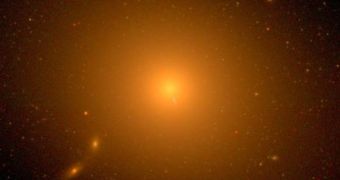Messier 87 is a nearby, giant, elliptical galaxy, which has fascinated astronomers for quite a long time. It's the largest and brightest in the northern Virgo Cluster, and it is located only 55 million light-years away from us. M87 is also a popular target with amateur and professional astronomical studies, and one such research has recently shown that the black hole lurking at the center of the galaxy is the heaviest ever observed anywhere in the Universe.
According to the new numbers, the center of Messier 87 is occupied by a black hole that is two to three times heavier than first estimates. Astrophysicists say that it weighs in at about 6.2 billion times the mass of our Sun, which definitely grants it a pass in the supermassive black hole group. Speaking at the 214th meeting of the American Astronomical Society (AAS), researchers from the University of Texas in Austin said that other black holes in galaxies around us might also be larger than first thought.
This discovery “is important for how black holes relate to galaxies. If you change the mass of the black hole, you change how the black hole relates to the galaxy,” Astronomer Jens Thomas, one of the members of the research team, based at the Max Planck Institute for Extraterrestrial Physics, in Germany, pinpointed. “We did not expect it at all,” team member Karl Gebhardt, from the UTA, added.
Virgo A is one of the standard-galaxies in black hole studies, astronomers share. For starters, it's very large, and it also shoots out a jet of light and other radiations from its highly active core. It's most active in the radio wavelengths, although other segments of the electromagnetic spectrum are also covered by its emissions. The stuff coming out of it travels at almost the speed of light, after coming in contact with the black hole's attraction and the huge magnetic fields it generates.
The find could also help scientists understand quasars, the mysterious formations up to 100 billion times heavier than the Sun, which help form galaxies and black holes in the distant Universe. “The suspicion was before that the quasar masses were wrong. If we increase the mass of M87 two or three times, the problem almost goes away,” Gebhardt explained, quoted by Space.

 14 DAY TRIAL //
14 DAY TRIAL //